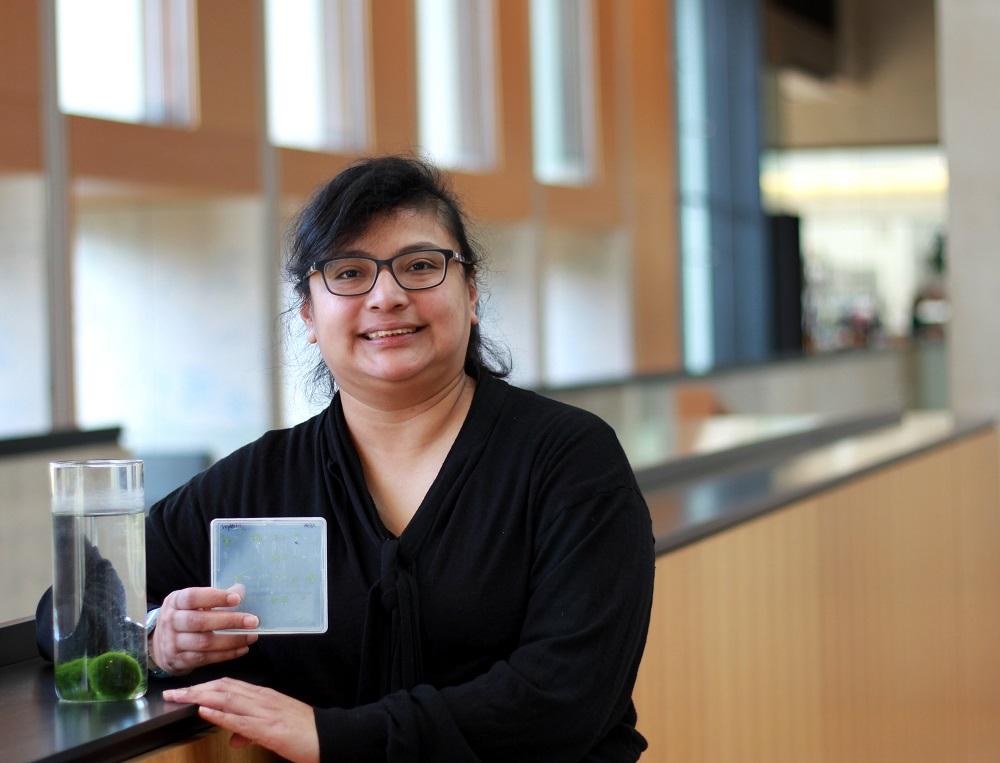
Dr Dora Cano Ramirez
Research Associate
Dora is studying how random gene expression in plants affects their survival under fluctuating environments.
What is your research question?
I am looking at the stochastic nature, or randomness, of gene expression in plants growing under variable environmental stresses. It is thought that noisy genes, which show variability in gene expression, give plants some advantage when they are growing in changeable environments, but we don’t fully understand how this happens. If plants are exposed to unseasonal or extreme stresses, such as below freezing temperatures in late spring or an extended heat wave, it could wipe out a whole crop. I want to find out if variability in gene expression has an impact on fitness and survival and whether this could potentially help with developing crops that are more adaptable to unexpected changes in temperature.
Why did you choose to study science?
My mum is a retired nurse and the only books around the house when I was a child were medical textbooks. I used to look at the books from a very young age – even before I could read – and marvel at the anatomy diagrams. When I started school, my older sister told me about microbiology and that the world was full of tiny living things that you could only see under a microscope. And then I learnt about Chemistry and Physics and that there were even smaller things that were not visible to us even if we used a microscope. This captured my imagination and I wanted to find out more about these “invisible” things. I always wanted to have one of those Chemistry lab kit toys, but my mum was worried it might be dangerous and I might blow something up. So, you can imagine how excited I was when I got to college and was able to go into a real Chemistry lab and do experiments. But it wasn't until I got a travel grant to attend an international conference during my Masters that really cemented by decision to make science my career. I was terrified as it was the first time that I had given a talk at an international conference and the first time delivering a talk in English. It blew my mind, especially as I was encouraged by female Professors such as Katayoon Dehesh. I really enjoyed it and was surrounded by other people who were also excited by science just as much as me – I knew then that this is the place I wanted to be.
What really interests you about science?
I studied Chemistry and Biology during college and had the opportunity to do work placements in different labs, often in medical or hospital settings. I really loved working with laboratory equipment – plate readers, oximeters, doing biochemical assays, growing cells, examining chromosomes, isolating mitochondria – I loved it all. I was also really interested in Genetics so I decided that if I wanted to do more genetics I would have to move to plants as there is much more scope for genetics research. I was initially interested in plant chemistry and started looking at lipids in the plasma membrane. It was Prof. Antony Dodd’s visit to Universidad Nacional Autónoma de México (UNAM) that introduced me to circadian rhythms – 1 year later I was enrolled in a PhD at the University of Bristol studying how plants tell the time with him.
While studying circadian rhythms in Arabidopsis for my PhD, I started a little side project on my pet plants. I had a few Marimo lake balls sitting in water on my desk. I noticed these little algae balls float and sink at different times of the day and that their buoyancy was affected on cloudy days. I decided to find out why and devised a series of experiments that found they are buoyant in the light because photosynthesis causes bubbles to form on the balls and that this was controlled by circadian rhythms of photosynthesis. It started as a fun experiment and ended up getting a lot of public attention. It was a great example of how important curiosity is and how much fun it is to do science.
What advice do you have for girls thinking about studying science at degree level?
There are no limits to what you can do and never take a no for an answer. Also, curiosity is the most important thing to have. To be a good scientist you need to be curious, creative and kind – kind to yourself and also kind to your colleagues. Science is no longer done by a single person – it is a team effort and we all rely on one another to do good science. The senior levels in science are still dominated by men, but there are many men allies (like my current boss at SLCU) and fantastic women scientists coming through and changing the culture will help to see more women take these senior positions.
Do you have a female STEM role model?
I have strong memories of growing up watching astrophysicist and children’s TV science show host, Professor Julieta Norma Fierro Gossman. She was the first woman research scientist I had seen and her enthusiasm about science made me realise women also belong in science. Then while doing my undergraduate, I saw 2009 Nobel Prize winner in Chemistry, Professor Ada Yonath, on campus who won the Nobel for her work on ribosomes and would give talks to students. Also, my Master degree examiner Doctor Marietta Tuena Sangri (†) who was the first women biochemist in Mexico and Professor Ottoline Leyser are two other women who I also admire for their work.
(†) Died 03 February 2023
Connect with Dora on Twitter https://twitter.com/Dodka_
